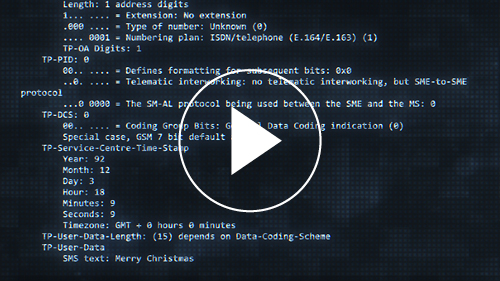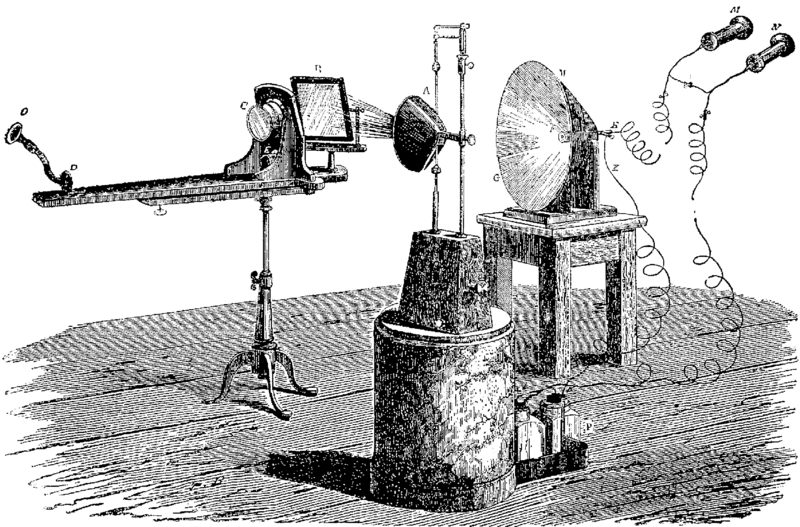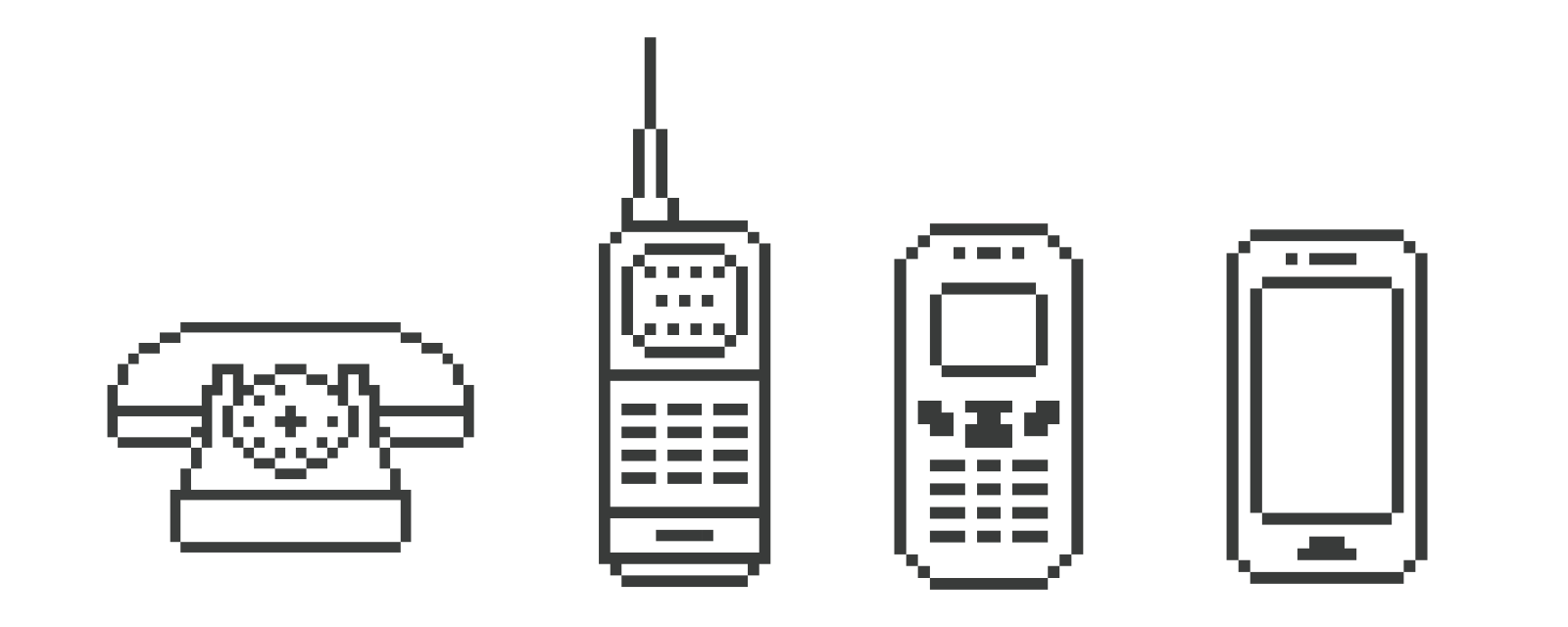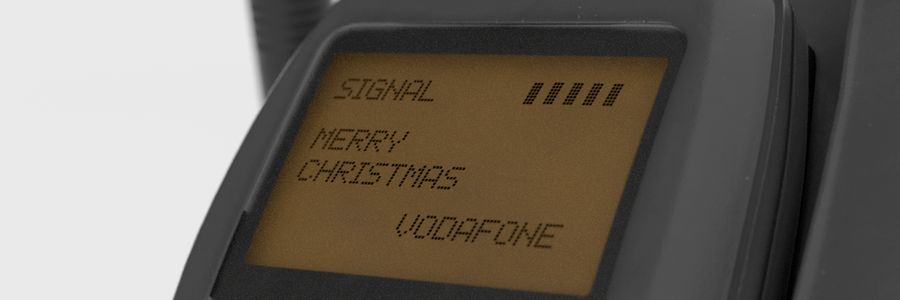15 LETTERS THAT CHANGED THE WORLD: VODAFONE AUCTIONS THE VERY FIRST SMS AS AN NFT
“MERRY CHRISTMAS” THE WORLD'S FIRST SMS
The world’s first SMS was received via the Vodafone network by Richard Jarvis, director of the telecommunications operator Vodafone, on December 3rd 1992. The message was "Merry Christmas". The NFT and the related smart contract represent the exclusive ownership of this historic digital artifact.

VODAFONE GROUP
“MERRY CHRISTMAS” THE WORLD’S FIRST SMS
Installation in acrylic and mixed media, staging the legendary mobile phone that received the first SMS.
The animation displays in a digital screen a replica of the original communication protocol of the world's first SMS. 29 x 19.5 cm
We join to this:
Non-fungible token: ERC-721
Token ID: 1
Minted on: 18/12/2021
Edition: 1/1
Smart Contract Address: 0x7ccc16b30893f98b9ae942d4a149aaa5320513f6


A BRIEF HISTORY OF TELECOMMUNICATION
We can consider the optical telegraph developed by Claude Chappe in 1794 as the ancestor of telecommunications.
At the end of the 19th century, the experiment of the physicist Heinrich Hertz confirmed the existence of electromagnetic waves predicted by the theory of James Clerk Maxwell a decade earlier. In honor of Heinrich Hertz, radio waves are called "Hertzian".
There are several types of telecommunication processes; those that allow the transmission of sound and image, associated or dissociated of text, or of computer data. Some are one-way - such as broadcasting or television - while others establish a dialogue between the transmitter and the receiver, as is the case with telephones for example.
The routing of information is carried out thanks to telecommunications networks. These can use different physical media depending on the content of the information to be transported, the speed of the desired transmission and the distance to be covered. The telephone network, for example, uses a combination of cables, optical fibers, microwave links and, for intercontinental communications, satellites.

Louis Figuier
Les Merveilles de la science, 1867 - 1891, book 6
THE STORY OF THE FIRST SMS
While a lot of technological breakthroughs like the Moon Landing in 1969 or the invention of the light bulb are well documented and known to the wider public, some others are not - even though they just as well changed how we live and interact with each other forever. Technological ‘firsts’ often happen when nobody is watching or expecting them. But when such moments arrive, it is clear that from there on, there will be an era ‘before’ and one ‘after‘.
When 22-year-old programmer Neil Papworth sat in front of his desktop computer on one Winter evening almost three decades ago, little did he know what type of monumental technological change he was about to turn from theory into reality.
Adding holiday greetings to the lines of code of a new mobile messaging protocol, laid the foundation of people coming closer together in a world where human interaction increasingly happens in the digital realm.
On 3rd December 1992, Neil Papworth wrote 'Merry Christmas' to Vodafone director Richard Jarvis who received the world’s first text message on his iconic Orbitel 901 mobile phone while he was at the company’s Christmas party.
As Neil Papworth stated later in an interview, he and his team of fellow software and testing engineers at a specialized telecoms development company were under pressure during the time leading up to Christmas 1992. He and his colleagues were trying to establish a new communications infrastructure for their client Vodafone to enable people to send short, written messages to each other’s mobile phones. After countless attempts and iterations of the code, the sending and receiving of text via Vodafone’s mobile network finally worked.
The transmission of the short text message that only included 15 characters eventually was a pivotal moment in the history of mobile communication technology. The absence of a newspaper archive about this discovery in 1992 shows how far we were to imagine what had just happened. The communication software protocol that was used later became universally known as “Short Messaging Service” (SMS).
Vodafone and the back then hired team of external engineers were pioneers of a new digital age that laid the foundation for new ways of human communication through digital technologies, including social media and everything that came.
“In 1992, I had no idea just how popular texting would become, and that this would give rise to emojis and messaging apps used by millions. I only recently told my children that I sent that first text. Looking back with hindsight, it’s clearer to see that the Christmas message I sent was a pivotal moment in mobile history.”
- Neil Papworth

THE SMS AND ITS USE DURING THE LAST 30 YEARS
The first text was sent from a computer because there was no keyboard on mobile phones at that time. Since 1994, with the appearance of the Nokia 210, SMS can finally be sent from a cell phone. But for people, a phone was made to speak, not to write. To write, some people were using beaper devices like Tatoo or Tamtam (limited to 80 characters) so not many operators offered this service. Operators were using SMS to communicate with their subscribers.
In 1999, seven years after the first SMS that was sent through Vodafone, text messages could finally be exchanged on multiple networks, accelerating their usage and popularity. It becomes possible to exchange text messages, no mater the operator of the other user.
More affordable than calling, texting then quickly became the most used modern communication channel. "SMS" stands for Short Message Service. Indeed, an SMS is intended to be a small text limited to 160 characters. This number was considered short enough to limit the bandwith technically required, and long enough to transmit information from one person to another. Twitter also determined the maximum number of characters to 160. This limitation will support globally the use of abbreviations and emoticons.
Many people remember the years when this number of characters really counted and led users to type shortened words and abbreviations in order not to exceed it. In 2004, the first packages that included unlimited SMS in the evenings and on weekends or part of the week appeared. From 2012, operators generalize packages with unlimited SMS and MMS. About 6 000 billions of SMS are sent every year according to the ITU, International Communication Union (the United Nations specialized agency for information and communication technologies, 2014 report).
The diffusion of written information has become widespread since the rise of smartphones and we now communicate more by writing than by phone calls. Messages with greetings for Christmas, Hanukkah, Eid and many other holidays are sent by billions of people all over the world using texts, videos, audio messages, and emojis.

FROM SMS PAST TO NON-FUNGIBLE FUTURE
Text messaging has surely changed the world, enabling people to stay in touch with each other in a more frequent and intimate way.
Similar to SMS back in the 1990’s and early 2000’s, blockchain technology has risen and seen an accelerating mass adoption over the past decade. Ever since the Bitcoin Whitepaper was published by anonymous ‘Satoshi Nakamoto’ in 2009, our world entered yet a new era of technological breakthroughs.
As part of the ongoing paradigm shift from Web2 to Web3, Non-Fungible Tokens (NFTs) have entered the mainstream in the past 12 months after their general concept was already established a few years ago - similar to what Vodafone accomplished with sending the first-ever SMS to a mobile phone. NFTs serve as unique, blockchain-based ownership certificates for a variety of digital assets, such digital art, collectibles, in-game items or web domains.
NFTs AND THE ART MARKET
Digital art is revolutionizing the art market. With their unique properties, NFTs, Non Fungible Tokens, help to protect digital works through an encrypted license that allows the collector to be the only holder of the artwork, not being able to be copied.
Indeed, NFTs are digital certificates that can't be falsified and that attest the authenticity of a virtual object. NFTs do not exist in the material world. What the buyer has is a unique and secure code composed mostly of letters, numbers and special characters. NFTs are non-fungible, therefore non-interchangeable. Until recently, any digital image was fungible and could be duplicated and sent over the web. This has all changed with the advent of the blockchain, a participatory and decentralized computer system that allows transactions to be certified. It is possible to certify that a digital creation has been purchased by a certain user by generating a unique code. It is this uniqueness that makes the object non-fungible and therefore not replaceable by another.
The first NFTs appeared in the 2010s, we can mention for example Rare Pepe and in 2017 cryptopunks amongst others. Now, NFTs are developing in many fields such as music, sports or design. NFTs have shaken up the very concept of property; what is certain is that their place in the art market is bound to evolve considerably.
"The first printed book, the first phone call, the first email, all these inventions have changed our lives and communication in the world. This first text message received in 1992 is a historic testament to human and technological progress. It transmitted a message of joy, 'Merry Christmas'."
- Maximilien Aguttes
LOT DETAILS
This associated NFT, Non-Fungible Token, is a protocol replica of the world's first SMS. It was received on the Vodafone network by Richard Jarvis, director of the telecommunications operator Vodafone, on December 3rd 1992. The message said "Merry Christmas".
The NFT Smart Contract represents the exclusive ownership of a detailed and unique digital replica of the original communication protocol that transmitted the world’s first SMS. The exclusive NFT was minted in an edition of 1 and Vodafone assures that Vodafone will not mint another NFT related to the first SMS in the future.
The smart contract also gives access to a certificate issued by Vodafone CEO, and signed by Nick Read, on 13/12/2021 that confirms the authenticity and uniqueness of this NFT.
Vodafone precises in his Smart Contract that the buyer of the lot will receive the following assets:
1. A detailed replica of the original communication protocol created by Vodafone, which documents the sending/receiving of the world's first SMS. The buyer receives the replica as a PCAP file. In addition, the buyer receives the replica of the original communication protocol as TXT files (coded/uncoded versions) and as PDF files (coded/uncoded versions).
2. A digital frame in the form of a physical asset (29x19.5cm). In this frame, a 3D animation is shown in which the mobile phone is presented at the moment of receiving the world’s first SMS. In addition to the physical asset, the buyer also receives the included 3D animation as an MP4 file as a digital version.
3. An animated version of the entire replica of the original communication protocol code, which documents both the sending and the reception of the world’s first SMS.
4. A certificate guaranteeing the authenticity and uniqueness of the NFT "Merry Christmas" The World's First SMS to the owner, signed by Vodafone Group CEO Nick Read (Smart Contract/Token ID/Mint-Date/Edition 1/1)
PRESS ARTICLES
NY Times
Telecoms.com
Britannica
Euronews
AUCTION DETAILS
“MERRY CHRISTMAS” THE WORLD'S FIRST SMS
Auction: Tuesday, December 21, 2021 at 03:00 pm
Aguttes • 164 bis, avenue Charles-de-Gaulle • Neuilly-sur-Seine • France


CONTACT
Maximilien Aguttes
+33 7 68 02 88 68
maximilien@aguttes.com
PUBLIC RELATIONS
France
Anne-Sophie Philippon
+ 33 6 27 96 28 86
rp@lepetitstudiolo.fr
International
Julian Roup
+ 44 7970 563958
info@bendigopr.co.uk
We can consider the optical telegraph developed by Claude Chappe in 1794 as the ancestor of telecommunications.
At the end of the 19th century, the experiment of the physicist Heinrich Hertz confirmed the existence of electromagnetic waves predicted by the theory of James Clerk Maxwell a decade earlier. In honor of Heinrich Hertz, radio waves are called "Hertzian".
There are several types of telecommunication processes; those that allow the transmission of sound and image, associated or dissociated of text, or of computer data. Some are one-way - such as broadcasting or television - while others establish a dialogue between the transmitter and the receiver, as is the case with telephones for example.
The routing of information is carried out thanks to telecommunications networks. These can use different physical media depending on the content of the information to be transported, the speed of the desired transmission and the distance to be covered. The telephone network, for example, uses a combination of cables, optical fibers, microwave links and, for intercontinental communications, satellites.

Louis Figuier
Les Merveilles de la science, 1867 - 1891, book 6
THE STORY OF THE FIRST SMS
While a lot of technological breakthroughs like the Moon Landing in 1969 or the invention of the light bulb are well documented and known to the wider public, some others are not - even though they just as well changed how we live and interact with each other forever. Technological ‘firsts’ often happen when nobody is watching or expecting them. But when such moments arrive, it is clear that from there on, there will be an era ‘before’ and one ‘after‘.
When 22-year-old programmer Neil Papworth sat in front of his desktop computer on one Winter evening almost three decades ago, little did he know what type of monumental technological change he was about to turn from theory into reality.
Adding holiday greetings to the lines of code of a new mobile messaging protocol, laid the foundation of people coming closer together in a world where human interaction increasingly happens in the digital realm.
On 3rd December 1992, Neil Papworth wrote 'Merry Christmas' to Vodafone director Richard Jarvis who received the world’s first text message on his iconic Orbitel 901 mobile phone while he was at the company’s Christmas party.
As Neil Papworth stated later in an interview, he and his team of fellow software and testing engineers at a specialized telecoms development company were under pressure during the time leading up to Christmas 1992. He and his colleagues were trying to establish a new communications infrastructure for their client Vodafone to enable people to send short, written messages to each other’s mobile phones. After countless attempts and iterations of the code, the sending and receiving of text via Vodafone’s mobile network finally worked.
The transmission of the short text message that only included 15 characters eventually was a pivotal moment in the history of mobile communication technology. The absence of a newspaper archive about this discovery in 1992 shows how far we were to imagine what had just happened. The communication software protocol that was used later became universally known as “Short Messaging Service” (SMS).
Vodafone and the back then hired team of external engineers were pioneers of a new digital age that laid the foundation for new ways of human communication through digital technologies, including social media and everything that came.
“In 1992, I had no idea just how popular texting would become, and that this would give rise to emojis and messaging apps used by millions. I only recently told my children that I sent that first text. Looking back with hindsight, it’s clearer to see that the Christmas message I sent was a pivotal moment in mobile history.”
- Neil Papworth

THE SMS AND ITS USE DURING THE LAST 30 YEARS
The first text was sent from a computer because there was no keyboard on mobile phones at that time. Since 1994, with the appearance of the Nokia 210, SMS can finally be sent from a cell phone. But for people, a phone was made to speak, not to write. To write, some people were using beaper devices like Tatoo or Tamtam (limited to 80 characters) so not many operators offered this service. Operators were using SMS to communicate with their subscribers.
In 1999, seven years after the first SMS that was sent through Vodafone, text messages could finally be exchanged on multiple networks, accelerating their usage and popularity. It becomes possible to exchange text messages, no mater the operator of the other user.
More affordable than calling, texting then quickly became the most used modern communication channel. "SMS" stands for Short Message Service. Indeed, an SMS is intended to be a small text limited to 160 characters. This number was considered short enough to limit the bandwith technically required, and long enough to transmit information from one person to another. Twitter also determined the maximum number of characters to 160. This limitation will support globally the use of abbreviations and emoticons.
Many people remember the years when this number of characters really counted and led users to type shortened words and abbreviations in order not to exceed it. In 2004, the first packages that included unlimited SMS in the evenings and on weekends or part of the week appeared. From 2012, operators generalize packages with unlimited SMS and MMS. About 6 000 billions of SMS are sent every year according to the ITU, International Communication Union (the United Nations specialized agency for information and communication technologies, 2014 report).
The diffusion of written information has become widespread since the rise of smartphones and we now communicate more by writing than by phone calls. Messages with greetings for Christmas, Hanukkah, Eid and many other holidays are sent by billions of people all over the world using texts, videos, audio messages, and emojis.
FROM SMS PAST TO NON-FUNGIBLE FUTURE
Text messaging has surely changed the world, enabling people to stay in touch with each other in a more frequent and intimate way.
Similar to SMS back in the 1990’s and early 2000’s, blockchain technology has risen and seen an accelerating mass adoption over the past decade. Ever since the Bitcoin Whitepaper was published by anonymous ‘Satoshi Nakamoto’ in 2009, our world entered yet a new era of technological breakthroughs.
As part of the ongoing paradigm shift from Web2 to Web3, Non-Fungible Tokens (NFTs) have entered the mainstream in the past 12 months after their general concept was already established a few years ago - similar to what Vodafone accomplished with sending the first-ever SMS to a mobile phone. NFTs serve as unique, blockchain-based ownership certificates for a variety of digital assets, such digital art, collectibles, in-game items or web domains.
NFTs AND THE ART MARKET
Digital art is revolutionizing the art market. With their unique properties, NFTs, Non Fungible Tokens, help to protect digital works through an encrypted license that allows the collector to be the only holder of the artwork, not being able to be copied.
Indeed, NFTs are digital certificates that can't be falsified and that attest the authenticity of a virtual object. NFTs do not exist in the material world. What the buyer has is a unique and secure code composed mostly of letters, numbers and special characters. NFTs are non-fungible, therefore non-interchangeable. Until recently, any digital image was fungible and could be duplicated and sent over the web. This has all changed with the advent of the blockchain, a participatory and decentralized computer system that allows transactions to be certified. It is possible to certify that a digital creation has been purchased by a certain user by generating a unique code. It is this uniqueness that makes the object non-fungible and therefore not replaceable by another.
The first NFTs appeared in the 2010s, we can mention for example Rare Pepe and in 2017 cryptopunks amongst others. Now, NFTs are developing in many fields such as music, sports or design. NFTs have shaken up the very concept of property; what is certain is that their place in the art market is bound to evolve considerably.
"The first printed book, the first phone call, the first email, all these inventions have changed our lives and communication in the world. This first text message received in 1992 is a historic testament to human and technological progress. It transmitted a message of joy, 'Merry Christmas'."
- Maximilien Aguttes
LOT DETAILS
This associated NFT, Non-Fungible Token, is a protocol replica of the world's first SMS. It was received on the Vodafone network by Richard Jarvis, director of the telecommunications operator Vodafone, on December 3rd 1992. The message said "Merry Christmas".
The NFT Smart Contract represents the exclusive ownership of a detailed and unique digital replica of the original communication protocol that transmitted the world’s first SMS. The exclusive NFT was minted in an edition of 1 and Vodafone assures that Vodafone will not mint another NFT related to the first SMS in the future.
The smart contract also gives access to a certificate issued by Vodafone CEO, and signed by Nick Read, on 13/12/2021 that confirms the authenticity and uniqueness of this NFT.
Vodafone precises in his Smart Contract that the buyer of the lot will receive the following assets:
1. A detailed replica of the original communication protocol created by Vodafone, which documents the sending/receiving of the world's first SMS. The buyer receives the replica as a PCAP file. In addition, the buyer receives the replica of the original communication protocol as TXT files (coded/uncoded versions) and as PDF files (coded/uncoded versions).
2. A digital frame in the form of a physical asset (29x19.5cm). In this frame, a 3D animation is shown in which the mobile phone is presented at the moment of receiving the world’s first SMS. In addition to the physical asset, the buyer also receives the included 3D animation as an MP4 file as a digital version.
3. An animated version of the entire replica of the original communication protocol code, which documents both the sending and the reception of the world’s first SMS.
4. A certificate guaranteeing the authenticity and uniqueness of the NFT "Merry Christmas" The World's First SMS to the owner, signed by Vodafone Group CEO Nick Read (Smart Contract/Token ID/Mint-Date/Edition 1/1)
PRESS ARTICLES
NY Times
Telecoms.com
Britannica
Euronews
AUCTION DETAILS
“MERRY CHRISTMAS” THE WORLD'S FIRST SMS
Auction: Tuesday, December 21, 2021 at 03:00 pm
Aguttes • 164 bis, avenue Charles-de-Gaulle • Neuilly-sur-Seine • France


CONTACT
Maximilien Aguttes
+33 7 68 02 88 68
maximilien@aguttes.com
PUBLIC RELATIONS
France
Anne-Sophie Philippon
+ 33 6 27 96 28 86
rp@lepetitstudiolo.fr
International
Julian Roup
+ 44 7970 563958
info@bendigopr.co.uk



